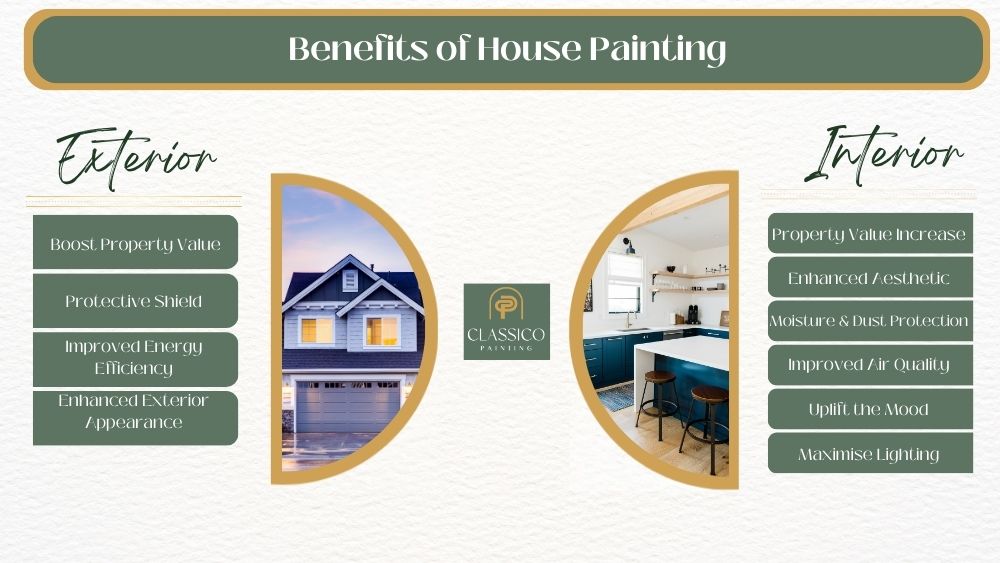There are numerous advantages to painting your house’s interior and exterior.
When it comes to the interior, painting can completely transform the interior’s aesthetic, improve the air quality, create a sense of calmness, warmth, or energy, and maximise the house lighting.
On the other hand, painting the house exterior can increase the house’s value and improve energy efficiency. But that’s not the only benefit.
This article also discusses whether you should paint your house yourself (DIY), how to choose a good painter (hiring a professional), how often you need to repaint your house interior, how to choose the interior and exterior paint colour, and tips to paint your home exterior.
In the next section, you can discover all the interior and exterior painting benefits shown in this diagram.

Benefits of Painting House Interior
The advantages of transforming a house include:
- Increasing its value.
- Improving its interior aesthetic.
- Protecting against moisture and dust.
- Improving air quality.
- Boosting the mood of tenants.
- Maximising the house’s lighting.
Let’s look at these 6 benefits of painting the house interior closely.
1. Increase the House Value
You’ll find that a fresh layer of paint can significantly enhance the value of your home. This is one of the main advantages of house painting. It’s not just about aesthetics; it’s also an investment strategy.
Using high-quality acrylic-latex paints on your exterior and interior walls can give them a fresh, updated appearance, which will certainly attract potential buyers.
Choosing the correct colours plays a vital role here. Neutral tones are generally safe as they appeal to various preferences. For exteriors, lighter shades can make your house seem bigger and more welcoming.
2. Enhance the Interior’s Aesthetic
Improving the aesthetic appeal isn’t just for show; it’s a brilliant way to make your living space more enjoyable and comforting.
With interior painting, you can transform your interiors, adding character and personality to each room. Choosing the right paint colour plays a crucial role here. Bright colours can open up small spaces, whilst darker shades add depth and warmth.
Be bold in experimenting with textures and techniques that can dramatically enhance the interior aesthetic.
3. Protect Against Moisture and Dust
It’s not just about looks; applying the right paint can also be a protective layer against moisture and dust.
Consider exterior painting with high-quality emulsion paints when planning your next paint job. They have excellent adhesion and flexibility and are resistant to peeling and blistering – ideal for protecting your home against harsh weather conditions.
Oil-based paints work wonders here. They form a hard, protective shell resistant to moisture and dust. Plus, they’re easy to clean!
Remember, it’s not just about choosing the right type of paint but also applying it correctly. A poorly done paint job will offer little protection.
4. Improve Air Quality
Believe it or not, certain paints can help improve air quality by reducing pollutants and eliminating odours. Specifically, zero VOC paints are a top choice when you’re looking to enhance air quality.
VOCs, or volatile organic compounds, are harmful chemicals that can be released into the atmosphere of your home over time.
Interior paints with low or zero VOC levels are ideal for those concerned about indoor pollution. They are just as effective as traditional paints regarding coverage and durability.
Furthermore, some brands even offer paint-and-primer combinations that also absorb odours!
5. Boost the Mood of Tenants
Choosing the right colours can uplift your tenants’ mood. Whether interior or exterior, every paint colour emits a different kind of positive energy into the surroundings. For instance, cool tones like blues and greens instil calmness, while warm hues like yellows and reds spark creativity.
Understanding different paint types is equally crucial. High gloss paints are perfect for high-traffic areas due to their durability, whereas matte finishes work best in low-light rooms for an elegant feel.
Remember, proper application techniques amplify the benefits of painting. Even strokes ensure uniformity while avoiding drips and retaining that professional finish.
In essence, picking strategic paint colours and employing effective painting methods enhances living conditions by creating a vibrant atmosphere that boosts your tenants’ spirits.
6. Maximise the House Lighting
You’ll find that playing with the natural and artificial lighting in your property can significantly change its overall vibe and appeal.
A fresh coat of paint on your interior walls, particularly in bright colours, can dramatically alter how light interacts within a space. Understanding the sheer variety of paint types is crucial here.
For instance, glossy paints reflect more light and are best for poorly lit rooms, while matte finishes absorb light and suit overly bright spaces.
Remember: painting techniques matter, too! Brushing or rolling on paint creates different textures that play with light differently. So don’t just slap paint on; think about how it will work with your lighting to create the perfect ambience in every room of your house.
Benefits of Painting House Exterior
There are advantages to painting the exterior of your house.
- Increase the property’s value
- Protect against external elements
- Improve the house’s energy efficiency
- Enhance the overall appearance of your property.
Let’s look at these 4 benefits closely.
1. Increase the Property Value
It’s a well-known fact that a fresh coat of paint can significantly enhance the value of your property. Choosing to paint your home on the inside and outside is one of the most cost-effective methods of increasing its value.
The advantages of house painting go beyond aesthetics; it also offers protection against weather damage.
Selecting the appropriate paint type is crucial. For exteriors, it is highly recommended to use acrylic emulsion paints as they are long-lasting and resistant to fading. Conversely, oil-based paints are ideal for high-traffic areas indoors because of their durable finish.
2. Protect Against External Elements
Applying a fresh coat of paint isn’t just about aesthetics; it’s also an excellent way to safeguard your home against external elements. Exterior paint acts as a protective shield for your exterior walls, blocking harmful UV rays and preventing weather damage.
It’s vital to choose the right paint type for this task. Acrylic emulsion paints are known for their durability and flexibility. They expand in heat and contract in cold without cracking.
You must pay attention to preparation before painting. Cleaning and repairing your exterior walls is crucial. Any dust or dirt can prevent the paint from adhering correctly. Use quality brushes or rollers for a smooth finish.
3. Enhance the Energy Efficiency
Improving energy efficiency isn’t only possible with insulation and double-glazed windows; a well-chosen paint colour can also play a significant role. When painting your home, consider the thermal properties of different hues.
Light colours, for example, are great for reflecting heat away from your home’s exterior surfaces, thereby keeping the interior cooler in hot weather.
On the other hand, darker shades absorb heat and can help keep your home warmer during colder months. Thus, choosing the right paint colour is an efficient way to manage your energy consumption.
So next time you plan on refreshing the look of your home exterior or interior, remember that it’s not just about aesthetics but energy efficiency.
Now, let’s transition into how painting can improve the exterior aesthetic of your house.
4. Enhance the Exterior Aesthetic
You’ll find that a fresh coat of paint can dramatically enhance the overall appeal of your property. The right exterior colour selection can significantly boost your home’s exterior aesthetics. Understanding different paint types and their applications is crucial to achieve this effect.
Emulsion-based paints, for example, are perfect for exterior walls due to their durability and ease of cleaning. They’re resistant to fading and cracking, keeping your home’s facade looking fresh for longer.
Try the classic brushing or rolling for a smooth finish when considering painting techniques. For textured surfaces, spraying might be more effective.
Should I Paint My House Myself?
It’s a crucial decision to make between DIY vs hiring a professional painter when you want to paint your house. When you decide to paint your house by yourself, it is important to consider whether you have the skills and time necessary before deciding to paint your home yourself. You might think it’s as simple as choosing and applying a colour scheme, but there’s more to painting than meets the eye.
Understanding different paint types and their applications is essential. For instance, water-based paints are excellent for general use, while oil-based ones are preferable for high-moisture areas.
You should also know about proper painting techniques, like cutting in or rolling out, to ensure even coverage and avoid drips. It can be quite a task!
Hiring professional painters might be a better option if this seems daunting or you need more time. They’ll handle all these intricacies easily and deliver results that enhance your home’s appeal.
How to Choose a Good Painter?
What happens if you’ve decided not to go the DIY route? Now, it’s all about finding a professional painter who understands different painting techniques and paint types for your specific needs.
You need to start thinking about how to choose a good painter in Melbourne Ensure they have an extensive portfolio showcasing their work – a great indication of their skills and knowledge. Check if their services include post job cleaning too.
A good painting company should be able to provide practical advice on the best paint type for each surface in your home and how to maintain it for longevity. They’ll bring value by ensuring quality work that enhances the aesthetics and durability of your home’s surfaces.
Let’s talk about ‘how to paint the house interior’ next.
How to Paint the House Interior?
If you are asking yourself how to paint the inside of the house, there are a few steps you’d want to follow for optimal res.
Firstly, decide how to paint the house interior best suits your style and budget. High-quality paint is crucial; it ensures longevity and a flawless finish. Your home’s interior deserves nothing less than top-tier products.
Next, prepare your surfaces. This includes filling any holes or cracks and sanding down rough patches. Then comes priming – an essential stage often overlooked.
Lastly, apply your chosen colour carefully – this is where a professional painting company might come in handy! They have expertise in delivering smooth, even layers of paint that’ll transform your space into something spectacular.
And voila! You’ve mastered the art of interior painting.
How Often Do You Need to Repaint Your Home Interior?
You’re probably wondering how often to repaint the house interior. Well, it largely depends on the type of paint used and the wear and tear in each room.
High-traffic areas like kitchens and hallways may require new paint every 3-4 years, whilst low-activity spaces could go up to 5-10 years without needing a touch-up.
Remember that quality paints with high sheen levels are more durable on home surfaces and can withstand cleaning better than cheaper options. So, invest in good paints for longevity.
Also, watch for signs like chipping or fading, indicating it’s time for a repaint. Regularly giving your home surfaces a fresh coat will maintain its aesthetic appeal and increase durability.
How to Choose Paint Colour for House Interior?
Choosing paint colour for the house interior can be tricky. When picking a paint colour for a house interior, consider the room’s lighting and mood. A north-facing room might benefit from a warm hue, whilst south-facing rooms can handle cooler tones. Remember painting techniques: rolling gives a uniform coat, but brushing allows more control and texture.
Think about the type of paint too. Water-based paints are user-friendly and easy to clean up. Opt for oil-based paints for kitchens or bathrooms where moisture is high, as they’re more durable and water-resistant.
Lastly, choose low VOC (Volatile Organic Compounds) paints if indoor air quality is essential – they release fewer pollutants into your home environment.
How to Paint the House Exterior?
It’s crucial to understand that different factors come into play when shifting gears to the outside of your property. The house’s exterior is more exposed and requires sturdy paint types. Understanding how to paint the outside of the house properly is essential, and professional painters can offer useful insights.
Weather conditions significantly influence the longevity of your paintwork. Certain paints are better suited for humid environments, while others thrive in dry climates. Furthermore, consider sunlight exposure when choosing your paint type, as UV rays can cause fading over time.
In terms of technique, painting from the bottom helps prevent unsightly streaks. Use a quality roller or sprayer for larger areas and brushes for detailed work around windows and doors.
Now, let’s move on to how you pick the perfect colour for this grand exterior adventure.
How to Pick Paint Colour for House Exterior?
It’s not easy to select the right shade for your property’s façade, given the wide variety of colours available on the market.
You should consider your home’s architectural style and the landscape when you decide on how to pick paint colour for the house exterior.
A dull or old exterior paint can be off-putting for potential buyers if you’re planning to sell.
You should use masonry paint designed for outdoor use, as it will resist harsh weather conditions better than standard paints.
Don’t hesitate to test out different colours before deciding; small patches of sample colours can provide a visual cue to your house’s appearance after painting.





